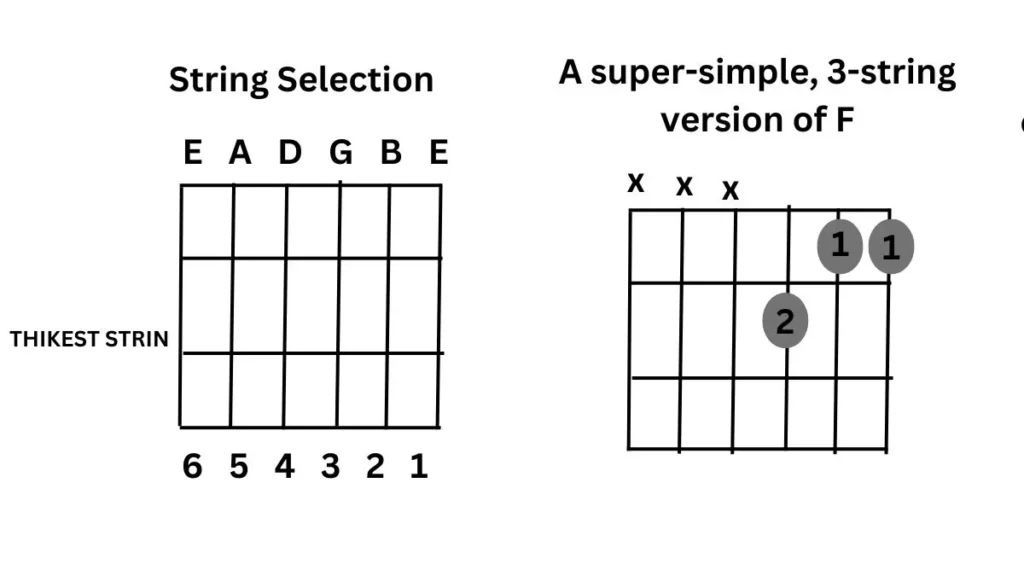Introduction: The F chord on the guitar is known to be a significant challenge for beginner guitarists. However, fear not! In this lesson, we will explore various approaches to playing the F chord correctly, including simpler alternatives and helpful techniques to improve your F chord sound. Let’s get started!
- Playing the F Chord Correctly: Before diving into easier alternatives, let’s understand the proper way to play the F chord:

- Position your fingers on the necessary frets, as shown in the F Major chord diagram.
- Ensure a clean strum by starting from the fourth string (D string) and avoiding the thinnest two strings (B and high E).
- Easier Versions of the F Chord: a) 3-Finger F Chord: This widely-used alternative alleviates the need for a full barre technique, offering relief to beginners:
- Position your fingers on the required frets without fully barring the first fret.
- Concentrate and develop finger dexterity to play this chord effectively.
b) Fmaj7 Chord: Fmaj7 provides an even easier alternative that still sounds great:
- Place your fingers on the designated frets, following the Fmaj7 chord diagram.
- Tips to Enhance Your F Chord Sound: To improve the sound of your F chords, consider the following bonus tricks: a) Experiment with Chord Voicings: Try different fingerings to discover the voicing that suits your style and preferences. b) Finger Pressure: Apply adequate pressure to produce clear notes without unnecessary force. c) String Selection: When playing the F chord, focus on strumming strings 1-4 and avoid accidentally playing the 6th string (E string).
Conclusion: Although the F chord may initially pose a challenge, with practice and persistence, you can conquer it. Begin with proper finger positioning and gradually progress to more advanced versions. Remember, learning the guitar takes time and dedication. Keep practicing and soon you’ll find it easier to transition to and from the F chord. Enjoy the process of mastering this important chord and creating beautiful music on your guitar!
3 easier alternatives to the F guitar chord
If you are struggling to play the F chord correctly, there are a few easier alternatives that you can try.
- The Fmaj7 chord: This chord is made up of the same notes as the F chord, but it is played with a different fingering. To play the Fmaj7 chord, place your index finger on the second fret of the second string, your middle finger on the second fret of the third string, and your ring finger on the third fret of the fourth string.
- The 3-string F chord: This chord is the easiest version of the F chord. To play it, place your index finger on the first fret of the second string and your ring finger on the third fret of the fourth string. You should only play the first three strings of the guitar when playing the 3-string F chord.
- The F chord with a capo: If you have a capo, you can use it to move the F chord up to a higher fret, making it easier to play. To do this, place the capo on the second fret of the guitar and then play the F chord as you normally would.
Tips for playing the F guitar chord
- Practice slowly: When you are first learning to play the F chord, it is important to practice slowly. This will help you to develop the muscle memory needed to play the chord correctly.
- Use a light touch: When you are playing the F chord, it is important to use a light touch. This will help to prevent you from muting the strings or making the chord sound muddy.
- Mute the unnecessary strings: When you are playing the F chord, you should only play the first four strings of the guitar. To mute the unnecessary strings, you can place your left hand fingers lightly on them.
- Don’t give up! The F chord is a difficult chord, but with practice, you will be able to play it correctly.
3 thoughts on “Mastering the F Chord on Guitar Easy Alternatives and Tips for Beginners”